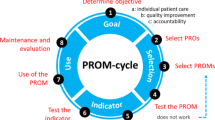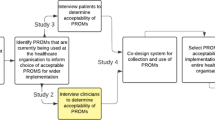Abstract
Purpose
Limited examples exist of successful Patient Reported Outcome Measure (PROM) implementation across an entire healthcare organisation. The aim of this study was to use a multi-stakeholder co-design process to develop a PROM collection system, which will inform implementation of routine collection of PROMs across an entire healthcare organisation.
Methods
Co-design comprised semi-structured interviews with clinicians (n = 11) and workshops/surveys with consumers (n = 320). The interview guide with clinicians focused on their experience using PROMs, preferences for using PROMs, and facilitators/barriers to using PROMs. Co-design activities specific to consumers focused on: (1) how PROMs will be administered (mode), (2) when PROMs will be administered (timing), (3) who will assist with PROMs collection, and (4) how long a PROM will take to complete. Data were analysed using a manifest qualitative content analysis approach.
Results
Core elements identified during the co-design process included: PROMs collection should be consumer-led and administered by someone other than a clinician; collection at discharge from the healthcare organisation and at 3–6 months post discharge would be most suitable for supporting comprehensive assessment; PROMs should be administered using a variety of modes to accommodate the diversity of consumer preferences, with electronic as the default; and the time taken to complete PROMs should be no longer than 5–10 min.
Conclusion
This study provides new information on the co-design of a healthcare organisation-wide PROM collection system. Implementing a clinician and patient informed strategy for PROMs collection, that meets their preferences across multiple domains, should address known barriers to routine collection.


Similar content being viewed by others
Data availability
All relevant data supporting the findings of this study are available within the manuscript and its supplementary information.
References
Porter, M. (2009). A strategy for health care reform - toward a value-based system. New England Journal of Medicine, 361(2), 109–112.
Porter, M. (2010). What is value in health care? New England Journal of Medicine, 363(26), 2477–2481.
Porter, M., Larsson, S., & Lee, T. (2013). The strategy that will fix health care. Harvard Business Review, 91(10), 1–19.
Porter, M., & Teisberg, E. (2006). Redefining health care: creating value-based competition on results. Harvard business press.
Bodenheimer, T., & Sinsky, C. (2014). From triple to quadruple aim: Care of the patient requires care of the provider. Annals of Family Medicine, 12(6), 573–576.
Churruca, K., Pomare, C., Ellis, L. A., Long, J. C., Henderson, S. B., Murphy, L. E. D., Leahy, C. J., & Braithwaite, J. (2021). Patient-reported outcome measures (PROMs): A review of generic and condition-specific measures and a discussion of trends and issues. Health Expectations, 24(4), 1015–1024.
Black, N. (2013). Patient reported outcome measures could help transform healthcare. British Medical Journal, 346, f167.
Williams, K., Sansoni, J., Darcy, M., Grootemaat, P., & Thompson, C. (2016). Patient Reported Outcome Measures: Literature Review. 2016, Australian commission on safety and quality in health care.
Sayah, F., Jin, X., & Johnson, J. (2021). Selection of patient-reported outcome measures (PROMs) for use in health systems. Journal of Patient Reported Outcomes. https://doi.org/10.1186/s41687-021-00374-2
NHS. Patient Reported Outcome Measures (PROMs). 2021 [cited 2022 10 January]; Available from: https://www.england.nhs.uk/statistics/statistical-work-areas/proms/.
Cancer, C.P.A. (2017). Effective, efficient, evolving: enhancing cancer control in Canada., CPAC: Toronto.
Ernstsson, O., Janssen, M., & Heintz, E. (2020). Collection and use of EQ-5D for follow-up, decision-making, and quality improvement in health care - the case of the Swedish National Quality Registries. Journal of Patient Reported Outcomes. https://doi.org/10.1186/s41687-020-00231-8
Peters, M., Crocker, H., Jenkinson, C., & Doll, H. (2014). Ray Fitzpatrick The routine collection of patient-reported outcome measures (PROMs) for long-term conditions in primary care: A cohort survey. BMJ Open, 4, e003968.
Gilbert, J., Howell, D., & King, S. (2012). Quality improvement in cancer symptom assessment and control: The provincial palliative care integration project (PPCIP. Journal of Pain and Symptom Management, 43, 663–678.
Rutherford, C., Campbell, R., Tinsley, M., Speerin, R., Soars, L., & Butcher, A. (2021). Madeleine king implementing patient-reported outcome measures into clinical practice across NSW: Mixed methods evaluation of the first year. Applied Research in Quality of Life, 16, 1265–1284.
Foster, A., Croot, L., Brazier, J., Harris, J., & O’Cathain, A. (2018). The facilitators and barriers to implementing patient reported outcome measures in organisations delivering health related services: A systematic review of reviews. Journal of Patient Reported Outcomes. https://doi.org/10.1186/s41687-018-0072-3
Stover, A. M., Haverman, L., van Oers, H. A., Greenhalgh, Joanne, Potter, C. M., Ahmed, S., Greenhalgh, J., Gibbons, E., Haverman, L., Manalili, K., Potter, C., Roberts, N., Santana, M., & Stover, A. M. (2021). Using an implementation science approach to implement and evaluate patient reported outcome measures (PROM) initiatives in routine care settings. Quality of Life Research, 30, 3015–33.
Briggs, M., Rethman, K., & Crookes, J. (2020). Implementing patient-reported outcome measures in outpatient rehabilitation settings: A systematic review of facilitators and barriers using the consolidated framework for implementation research. Archives of Physical Medicine and Rehabilitation, 101(10), 1796–1812.
O’Connell, S., Palmer, R., Withers, K., Saha, N., Puntoni, S., & Carolan-Rees, G. (2018). Requirements for the collection of electronic PROMS either “in clinic” or “at home” as part of the PROMs, PREMs and Effectiveness Programme (PPEP) in Wales: A feasibility study using a generic PROM tool. Pilot and Feasibility Studies. https://doi.org/10.1186/s40814-018-0282-8
Williams, K. & C. Thompson. (2018) Patient-reported outcome measures: Stakeholder interviews, Australian Commission on Safety and Quality in Health Care,: Sydney.
Greenhalgh, T., Jackson, C., Shaw, S., & Janamian, T. (2016). Achieving research impact through co-creation in community-based health services: Literature review and case study. The Milbank Quarterley, 94(2), 392–429.
Dawda, P., & Knight, A. (2018). Experience Based Co-design: a toolkit for Australia. Prestantia Health: Canberra.
Kyte, D., Anderson, N., Auti, R., Aiyegbusi, O. L., Bishop, J., Bissell, A., Brettell, E., Calvert, M., Chadburn, M., Cockwell, P., Dutton, M., Eddington, H., Forster, E., Hadley, G., Ives, N. J., Jackson, L., O’Brien, S., Price, G., Sharpe, K., … Williams, J. (2020). Development of an electronic patient reported outcome measure (ePROM) system to aid the management of patients with advanced chronic kidney disease. Journal of Patient-Reported Outcomes. https://doi.org/10.1186/s41687-020-00223-8
Knowles, S. E., Ercia, A., Caskey, F., Rees, M., Farrington, K., & Van der Veer, S. N. (2021). Participatory co-design and normalisation process theory with staff and patients to implement digital ways of working into routine care: the example of electronic patient-reported outcomes in UK renal services. BMC Health Services Research. https://doi.org/10.1186/s12913-021-06702-y
NSW Council of Social Services, Principles of co-design. 2017.
Sanders, E., & Stappers, P. (2008). Co-creation and the new landscapes of design. International Journal of Cocreation in Design and the Arts, 4(1), 5–18.
Aitken, J., & Shackleton, D. (2014). Co-creation and co-design: Applied research methods in healthcare service design. Sage Publications.
Australian Bureau of Statistics. 2016 Census Quickstats: Mornington Peninsula 2021; Available from: https://www.abs.gov.au/census/find-census-data/quickstats/2021/214.
Snowdon, D. A., Srikanth, V., Beare, R., Marsh, L., Parker, E., Naude, K., & Andrew, N. E. (2023). A landscape assessment of the use of patient reported outcome measures in research, quality improvement and clinical care across a healthcare organisation. BMC Health Services Research. https://doi.org/10.1186/s12913-023-09050-1
Andrew, N., Beare, R., & Ravipati, T. (2023). Developing a linked electronic health record derived data platform to support research into healthy ageing. International Journal of Population Data Science. https://doi.org/10.23889/ijpds.v8i1.2129
Snowdon, D., Srikanth, V., & Beare, R. (2023). Acceptability of the routine use and collection of a generic patient reported outcome measure from the perspective of healthcare staff: A qualitative study. J Patient Rep Outcomes. https://doi.org/10.1186/s41687-023-00617-4
Sayah, F. A., Lahtinen, M., Bonsel, G. J., Ohinmaa, A., & Johnson, J. A. (2021). A multi-level approach for the use of routinely collected patient-reported outcome measures (PROMs) data in healthcare systems. Journal of Patient Reported Outcomes, 5, 98.
Boyce, M., Browne, J., & Greenhalgh, J. (2014). The experiences of professionals with using information from patient-reported outcome measures to improve the quality of healthcare: A systematic review of qualitative research. BMJ Quality and Safety, 23, 508–518.
Meadows, K. (2011). Patient-reported outcome measures: An overview. British Journal of Community Nursing, 16(3), 146–151.
The EuroQol Group. (1990). EuroQol-a new facility for the measurement of health-related quality of life. Health Policy, 16(3), 199–208.
Hudak, P., Amadio, P., & Bombardier, C. (1996). Development of an upper extremity outcome measure: The DASH (disabilities of the arm, shoulder and hand). American Journal of Ind Med, 29, 602–608.
Snowdon, D. A., McGill, S., Altmann, C., Brooks, K., Everard, T., Le Fevre, K., & Andrew, N. E. (2022). Client and service factors associated with changes in health-related quality of life following community rehabilitation. Disability and Rehabilitation, 45, 512–522.
QSR International Pty Ltd. (2020) NVivo (released in March 2020).
Bengtsson, M. (2016). How to plan and perform a qualitative study using content analysis. NursingPlus Open, 2, 8–14.
Francis, J., Johnston, M., & Robertson, C. (2010). What is an adequate sample size? Operationalising data saturation for theory-based interview studies. Psychology & Health, 25, 1229–1245.
Heale, R., & Forbes, D. (2013). Understanding triangulation in research. Evidence-Based Nursing, 16, 98.
Brusco, N., Atkinson, V., & Woods, J. (2022). Implementing PROMS for elective surgery patients: feasibility, response rate, degree of recovery and patient acceptability. Journal of Patient Reported Outcomes. https://doi.org/10.1186/s41687-022-00483-6
Price, C. M., de Amanda, C., Williams, C., Smith, B. H., & Bottle, A. (2018). Implementation of patient-reported outcomes (PROMs) from specialist pain clinics in England and Wales: Experience from a nationwide study. European Journal of Pain, 23, 1368–1377.
Makhni, E. C., Swantek, A. J., Ziedas, A. C., Geoffrey Patterson, R., Allard, D., Day, C. S., & Betty, C. (2021). The Benefits of Capturing PROMs in the EMR. NEJM Catalyst Innovations in Care Delivery. https://doi.org/10.1056/CAT.21.0134
Olalekan, L. (2020). Key methodological considerations for usability testing of electronic patient-reported outcome (ePRO) systems. Quality of Life Research, 29, 325–333.
Aiyegbusi, O. L., Kyte, D., Cockwell, P., Marshall, T., Dutton, M., Walmsley-Allen, N., & Auti, R. (2018). Calvert M Development and usability testing of an electronic patient-reported outcome measure (ePROM) system for patients with advanced chronic kidney disease. Computers in Biology and Medicine, 101, 120–127.
Gabbard, J., McLouth, C., & Murea, M. (2020). Rapid electronic capturing of patient-reported outcome measures in older adults with end-stage renal disease: A feasibility study. American Journal of Hospice and Palliative Medicine, 38(5), 432–440.
The University of Melbourne. Co-Design and Implementation Effectiveness. 2022 [cited 2022 February]; Available from: https://clinicalresearch.mdhs.unimelb.edu.au/about-us/co-design-and-implementation-effectiveness.
Acknowledgements
We would like to thank the clinicians and consumers at Peninsula Health who participated in this study.
Funding
The authors declare that no funds, grants, or other support were received during the preparation of this manuscript.
Author information
Authors and Affiliations
Contributions
All authors contributed to the study conception and design. Material preparation and data collection was conducted by KN, EP and LM. Data analysis was performed by KN and DS. Data Triangulation was performed by KN, EP, LM, NA and DS. The first draft of the manuscript was written by KN and all authors commented on previous versions of the manuscript. All authors read and approved the final manuscript.
Corresponding author
Ethics declarations
Conflict of interest
The authors have no relevant financial or non-financial interests to disclose.
Ethical approval
This study was performed in line with the principles of the Declaration of Helsinki. Ethical approval for this study was obtained from the Peninsula Health Human Research Ethics Committee (AM/73610/PH-2021-281834(v1)).
Consent to participate
Informed consent was obtained from all individual participants included in the study.
Additional information
Publisher's Note
Springer Nature remains neutral with regard to jurisdictional claims in published maps and institutional affiliations.
Supplementary Information
Below is the link to the electronic supplementary material.
Rights and permissions
Springer Nature or its licensor (e.g. a society or other partner) holds exclusive rights to this article under a publishing agreement with the author(s) or other rightsholder(s); author self-archiving of the accepted manuscript version of this article is solely governed by the terms of such publishing agreement and applicable law.
About this article
Cite this article
Naude, K., Andrew, N.E., Srikanth, V. et al. Using a multi-stakeholder co-design process to develop a health service organisation-wide patient reported outcome measure collection system. Qual Life Res 33, 619–636 (2024). https://doi.org/10.1007/s11136-023-03552-5
Accepted:
Published:
Issue Date:
DOI: https://doi.org/10.1007/s11136-023-03552-5




